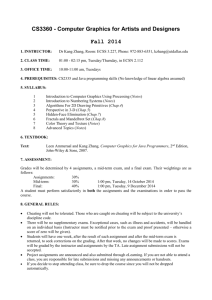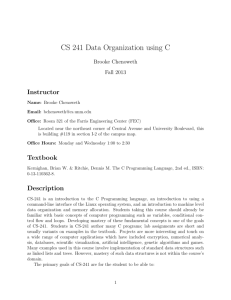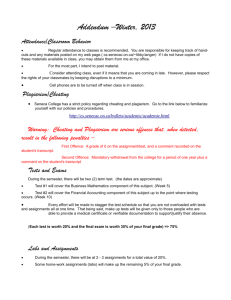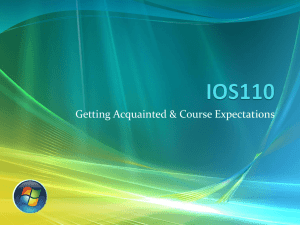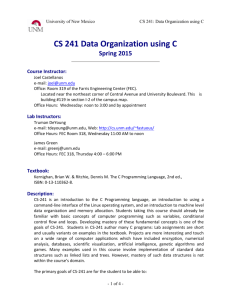266 Basic Statistical Analysis note: If
advertisement
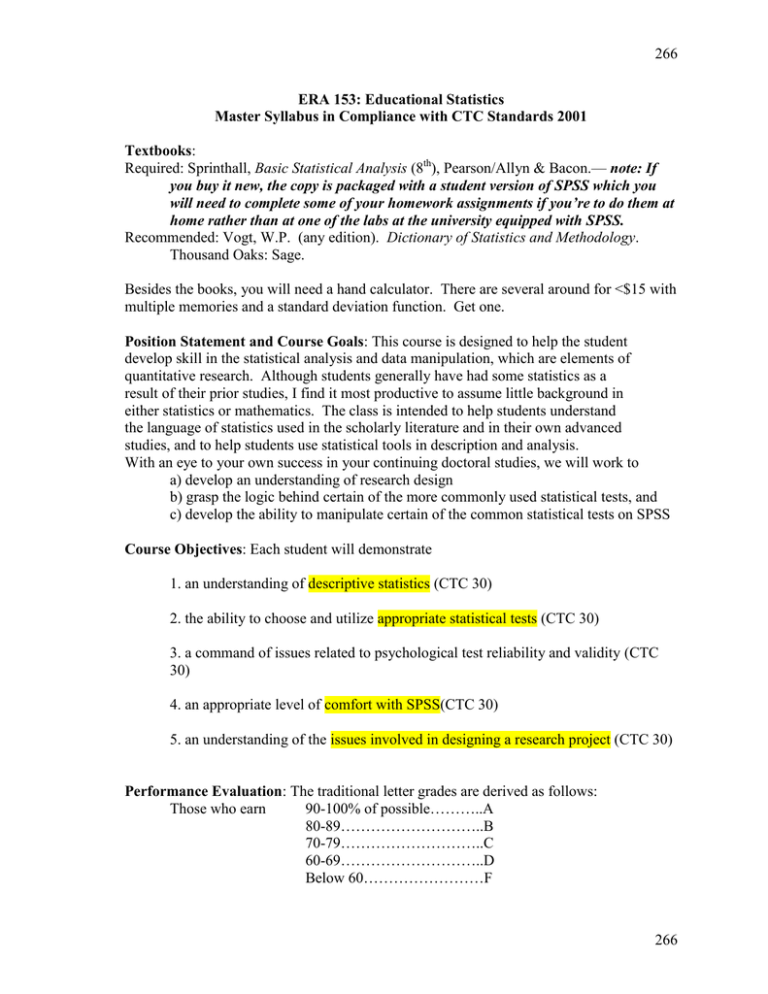
266 ERA 153: Educational Statistics Master Syllabus in Compliance with CTC Standards 2001 Textbooks: Required: Sprinthall, Basic Statistical Analysis (8th), Pearson/Allyn & Bacon.— note: If you buy it new, the copy is packaged with a student version of SPSS which you will need to complete some of your homework assignments if you’re to do them at home rather than at one of the labs at the university equipped with SPSS. Recommended: Vogt, W.P. (any edition). Dictionary of Statistics and Methodology. Thousand Oaks: Sage. Besides the books, you will need a hand calculator. There are several around for <$15 with multiple memories and a standard deviation function. Get one. Position Statement and Course Goals: This course is designed to help the student develop skill in the statistical analysis and data manipulation, which are elements of quantitative research. Although students generally have had some statistics as a result of their prior studies, I find it most productive to assume little background in either statistics or mathematics. The class is intended to help students understand the language of statistics used in the scholarly literature and in their own advanced studies, and to help students use statistical tools in description and analysis. With an eye to your own success in your continuing doctoral studies, we will work to a) develop an understanding of research design b) grasp the logic behind certain of the more commonly used statistical tests, and c) develop the ability to manipulate certain of the common statistical tests on SPSS Course Objectives: Each student will demonstrate 1. an understanding of descriptive statistics (CTC 30) 2. the ability to choose and utilize appropriate statistical tests (CTC 30) 3. a command of issues related to psychological test reliability and validity (CTC 30) 4. an appropriate level of comfort with SPSS(CTC 30) 5. an understanding of the issues involved in designing a research project (CTC 30) Performance Evaluation: The traditional letter grades are derived as follows: Those who earn 90-100% of possible………..A 80-89………………………..B 70-79………………………..C 60-69………………………..D Below 60……………………F 266 267 Homework........20% Tests (3)............45% Final..................35% Assignment: The homework assignments are designed to give the students practice in statistical manipulation and in evaluating research design problems. Students complete assignments in calculating z scores so that they understand the logic behind the standard scores that many testing agencies use. Students complete t-tests and analyses of variance so that they may determine when performance differences in groups of students or clients are non-random differences Students learn to calculate effect sizes that allow them to gauge the amount of variance explained by a particular treatment applied to subjects. Students learn to calculate and interpret correlation coefficients which allow them to quantify the strength of relationships such as homework and academic achievement, social class and school performance, verbal and problem-solving ability. Students will find the homework assignments listed in Blackboard. The process is to complete the assignments and then compare them against the answers which will also be posted. When the student’s works agrees with what is posted, send me an email with your name on it indicating that “Assignment #__ is complete.” Don’t send the email until the assignment has been completed. Except in the most unusual circumstances, the homework will be accepted only on, or before the day it is due. Please don’t plead special cases, just get the work done. Since notification comes to me by email, you can complete the tasks wherever you have internet access. Depending on circumstances, some of the materials may be presented via the Blackboard presentation system in which instance students will need to have access. The schedule below is tentative. From time to time we will take up research design issues, something not reflected in the schedule below. Tentative Schedule: Note that this schedule is tentative. We’ll adjust as needed (or according to your professor’s whim). The “Chap” designations refer to readings in Sprinthall. Week 1 Statistics, Scale, and Distributions of Scores: Chap 1-3 2 Data Distributions and the z score: Chap 4 3 Other standard scores: Chap 5, probability, Chap 6 4 Test #1. The z test and the one sample t-test, Chaps 7 & 8 5 One-Sample Tests continued 267 268 6 7 8 9 10 11 12 13 14 15 16 Research methodology and Two Sample Tests, Chaps 9 & 10 Test #2. Two Sample Tests, with related samples, Chap 15 One-way ANOVA, Chap 12 One-way ANOVA cont’d Test #3. Factorial ANOVA, Chap 12 Factorial ANOVA, cont’d Pearson Correlation, Chap 11 Spearman’s rho, Chap 11 Chi Square, Chap 13 General Review Comprehensive Final University Policies and Regulations Policy on Students with Disabilities. Upon identifying themselves to the instructor and the university, students with disabilities will receive reasonable accommodation for learning and evaluation. For more information, contact Services to Students with Disabilities in Madden Library 1049 (278-2811). Computers. “At California State University, Fresno, computers and communications links to remote resources are recognized as being integral to the education and research experience. Every student is required to have his/her own computer or have other personal access to a workstation (including a modem and a printer) with all the recommended software. The minimum and recommended standards for the workstations and software, which may vary by academic major, are updated periodically and are available from Information Technology Services or the University Bookstore. In the curriculum and class assignments, students are presumed to have 24-hour access to a computer workstation and the necessary communication links to the University’s information resources.” It is expected that you have access to Blackboard. If you do not have access, please call 278-7373 (Digital Campus) and provide your instructor with an update on the situation and status. Copyright. You will be provided with digital and/or print materials to support your learning in this course. As all of these materials are proprietary in nature, and most are protected by copyright, you may not reproduce or retain any of the materials for purposes other than work for this course, unless you are informed to the contrary. Students with Disabilities: Upon identifying themselves to the instructor and the university, students with disabilities will receive reasonable accommodation for learning and evaluation. For more information, contact Services to Students with Disabilities in the University Center Room 5 (278-2811). Honor Code: “Members of the CSU Fresno academic community adhere to principles of academic integrity and mutual respect while engaged in university work and related activities.” You should: d) understand or seek clarification about expectations for academic integrity in this course (including no cheating, plagiarism and inappropriate collaboration) 268 269 e) neither give nor receive unauthorized aid on examinations or other course work that is used by the instructor as the basis of grading. f) take responsibility to monitor academic dishonesty in any form and to report it to the instructor or other appropriate official for action. Instructors may require students to sign a statement at the end of all exams and assignments that “I have done my own work and have neither given nor received unauthorized assistance on this work.” If you are going to use this statement, include it here. Cheating and Plagiarism: "Cheating is the actual or attempted practice of fraudulent or deceptive acts for the purpose of improving one's grade or obtaining course credit; such acts also include assisting another student to do so. Typically, such acts occur in relation to examinations. However, it is the intent of this definition that the term 'cheating' not be limited to examination situations only, but that it include any and all actions by a student that are intended to gain an unearned academic advantage by fraudulent or deceptive means. Plagiarism is a specific form of cheating which consists of the misuse of the published and/or unpublished works of others by misrepresenting the material (i.e., their intellectual property) so used as one's own work." Penalties for cheating and plagiarism range from a 0 or F on a particular assignment, through an F for the course, to expulsion from the university. For more information on the University's policy regarding cheating and plagiarism, refer to the Class Schedule (Legal Notices on Cheating and Plagiarism) or the University Catalog (Policies and Regulations). Computers: "At California State University, Fresno, computers and communications links to remote resources are recognized as being integral to the education and research experience. Every student is required to have his/her own computer or have other personal access to a workstation (including a modem and a printer) with all the recommended software. The minimum and recommended standards for the workstations and software, which may vary by academic major, are updated periodically and are available from Information Technology Services (http://www.csufresno.edu/ITS/) or the University Bookstore. In the curriculum and class assignments, students are presumed to have 24-hour access to a computer workstation and the necessary communication links to the University's information resources." Disruptive Classroom Behavior: "The classroom is a special environment in which students and faculty come together to promote learning and growth. It is essential to this learning environment that respect for the rights of others seeking to learn, respect for the professionalism of the instructor, and the general goals of academic freedom are maintained. ... Differences of viewpoint or concerns should be expressed in terms which are supportive of the learning process, creating an environment in which students and faculty may learn to reason with clarity and compassion, to share of themselves without losing their identities, and to develop and understanding of the community in which they live . . . Student conduct which disrupts the learning process shall not be tolerated and may lead to disciplinary action and/or removal from class." Copyright policy: Copyright laws and fair use policies protect the rights of those who have produced the material. The copy in this course has been provided for private study, 269 270 scholarship, or research. Other uses may require permission from the copyright holder. The user of this work is responsible for adhering to copyright law of the U.S. (Title 17, U.S. Code). To help you familiarize yourself with copyright and fair use policies, the University encourages you to visit its copyright web page: www.csufresno.edu/library/about/policies/docs/copyrtpolicyfull.pdf. Digital Campus course web sites contains material protected by copyrights held by the instructor, other individuals or institutions. Such material is used for educational purposes in accord with copyright law and/or with permission given by the owners of the original material. You may download one copy of the materials on any single computer for noncommercial, personal, or educational purposes only, provided that you (1) do not modify it, (2) use it only for the duration of this course, and (3) include both this notice and any copyright notice originally included with the material. Beyond this use, no material from the course web site may be copied, reproduced, re-published, uploaded, posted, transmitted, or distributed in any way without the permission of the original copyright holder. The instructor assumes no responsibility for individuals who improperly use copyrighted material placed on the web site. Policy and regulations including but not limited to adding and dropping courses, the honor code, including cheating and plagiarism, copyright, and computer usage are located in the Class Schedule (www.csufresno.edu/ClassSchedule) and Catalog (www.csufresno.edu/catoffice/current/policies.html). 270
